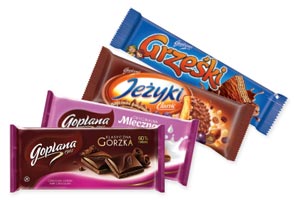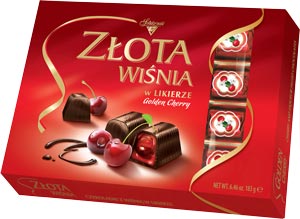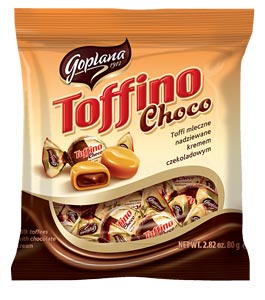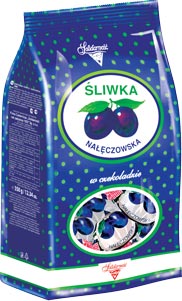It’s called a “blue ocean strategy.” A derivative from what some call white-space mapping, the blue-ocean approach encourages entrepreneurs to create uncontested market space instead of competing in “red oceans,” where there’s likely to be plenty of blood in the water.
It’s a strategy that Jan Kolański, president of the Colian Group, has embraced and evolved with to create the leading Polish-owned confectionery company. Starting from meager beginnings as a purveyor of spices, aromatic herbs and dried fruit with the creation of Ziolopex in 1990, Kolański has — through timely and thoughtful acquisitions — created a company that posted €212.5 million in sales last year.
The European Candy Kettle Club (ECKC)’s recognition of his efforts, which culminated in presenting him with the 2017 ECKC Award last year on Oct. 19 in Warsaw, places Kolański in very select company. Past recipients have included Michele Ferrero, Rudolf Sprüngli, Klaus Jabobs, Hans Riegel, and Sir Adrian Cadbury to name just a few. To get there, however, Kolański had to cross many bridges.
At-a-Glance: Colian Holding SA
Headquarters: Opatówek, Poland
2016 Sales: €212.5 million
Segmentation: Confectionery – €137.5 million (65%); Beverages – €33 million (16%); Culinary Products – €26.5 million (12%); Logistics – €15.5 million (7%)
Employment: 1,846; confectionery – 1,222
Products: Confectionery only — wafers, pralines, biscuits, jelly, chocolate bars, candied products, jellies, toffee, caramels
Yield: 70,000 tons per year (confectionery)
Brands (confectionery): Goplana, Solidarność, Grześki, Justrzenka, Familijne, Akuku!, Jeżyki, Famous Names and Elizabeth Shaw
Management Board: Jan Kolański, president of the board; Marcin Szuława, member of the board.
Given that his hometown of Kalisz has 32 bridges, the self-made millionaire already had the proper conditioning, not to mention drive. One of the challenges involved business diversification. In 2001, Kolański started investing in sweet treats. It started with the purchase of shares of Jutrzenka, a company producing cookies, biscuits and sweets in Bydgoszcz, Poland. Gradually, he acquired a majority of the Jutrzenka shares by early 2004. After restructuring the company in 2004, Kolański purchased the Polish Goplana brand and its production facility, located in Poznań, from Nestlé.
In the following years, Jutrzenka, under the leadership of Kolański, made significant acquisitions. Kaliszanka, known for the Grześki wafers, joined the company in 2005. The strategy of investing in strong brands and business diversification is another step in the company's development that led it to go beyond the confectionery industry and take over the Hellena brand in 2007, offering carbonated and non-carbonated beverages. Thanks to a well thought-out and consistent strategy, Oranżada Hellena became a leader in the orangeade category.
In 2008, the companies were consolidated; Jutrzenka changed its name to Jutrzenka Holding SA (currently Colian Holding SA) and the operating activity was taken over by Colian Sp. z o. o.
In the following year, to respond to the growing logistical needs of the group, Colian Logistics was founded to improve the distribution of the holding company's products, regardless if they were confections, coriander or canned beverages.
Colian Logistics also provides services to other entities in Poland and abroad.
Following a name change in 2011 — Colian Holdings rolls of the tongue easier for non-Poles than Jutrzenka Holdings — Kolański acquired the Solidarność company, a manufacturer of pralines, jellies and chocolate candies in 2013.
Observers following Kolański’s wheelings and dealings questioned whether he overpaid for the 60-year-old company (210 million PLN), which is known for its Śliwka Nałęczowska, a classic Polish confection featuring a chocolate-enrobed candied plum.

Kolański smiled when reminded of the situation.
“I had lengthy talks with Solidarność prior to the acquisition,” he explains. “I knew I was paying for high quality brands. Their plums were No. 1 in that segment.” And, as Kolański pointed out in a Newsweek interview done at the time, the acquisition addressed a void that the confectionery group eagerly wanted to — literally — fill, which was pralines, the fastest-growing market segment at the time.
“Recently the iconic product of the Colian company – Śliwka Nałęczowska - has been recognized as the No. 1 confectionery product purchased by tourists at Polish airports," he points out. It also received the prestigious Ars Coquinaria award from the Gastronomic Academy in Poland within the Polish Product category. As Kolański explains, the jury appreciated not only the original taste of Śliwka Nałęczowska, but the product’s superior quality, its traditional recipe as well as the methods of production.
Two years later, Colian Holdings made its first non-Polish acquisition, acquiring Elizabeth Shaw from Norwegian fund Capital AS. The famed premium British brand opened the door for expanding exports sales into the U.K. and elsewhere.
Today, confections account for 65 percent of Colian Holding’s revenues. That’s not a coincidence. As Kolański pointed out during a Taste the Future conference organized for his customers and partners in Warsaw the same day he received the ECKC award, Poland’s gross national product rose 3.9 percent last year. Sweets, however, outpaced the national economy, reaching 4.6 percent annual growth.
And there’s certainly room to grow — Polish per capita consumption of confections is 4.3 kilos —compared with that of Switzerland (10.5 kilos) or the U.K. (11 kilos).

“What's more, it is a category that brings satisfaction and joy," says Kolański. That’s certainly evident in the marketing campaign the company rolled out earlier this year for Grześki, its impulse wafer line. The marketing slogan “You wouldn’t deny a child this?” was designed to fill the gap between younger and mature consumers. It aims to attract consumers of all ages.
The campaign’s back story involves sharing, whether it’s father and son, travel companions, or television-watching partners. In the end, “One doesn’t grow out of loving Grześki” the television commercial asserts.
The campaign also underscores what Kolański envisions for Colian in confections, that is its role to improve the indulgent experience, be it through traditional products such as wafers or through innovations such as filled jellies.
For example, the Familijne wafer line represents the most traditional confection on the market. A few years ago, innovations in this segment were introduced by Wafle Gofrowe products, which made the company a category leader.
“We were the first to introduce aerated creams into our line of wafers," says Kolański. In addition, the company offers two types of creams in one wafer, for example strawberry and cream or cocoa and cream. Besides the traditional thin and light wafers, there are also Familijne Gofrowe or "waffles” – so called because they have thicker bases, wafers that provide consumers with a heartier crunch and a varied texture.
In that same innovative approach, the company launched a wafer product containing pieces of blackcurrants in a yogurt filling. In order to take advantage of the benefits of convenience and sharing as well as better-for-you trends among consumers, the company also developed the Familijne 2GO product, four wafer rods filled with milk and chocolate cream. It, too, is the first such item within the market segment. The innovative Familijne 2GO have been recognized by the industry and the market, winning the prestigious titles of Perła Rynku (Market Pearl) FMCG 2016, Best Product - Consumers' Choice 2017 and Hit of FMCG 2017.

To take advantage of the global snacking trend, Colian has applied the same strategy seen in the Familijne brand into Grześki. In this segment, products featuring waffle wafers that combine layers of vanilla cream and hazelnut cream and incorporate hazelnut pieces have underscored Kolański’s goal of being a market leader in quality, innovation and consumer satisfaction.
“We don’t want to compete on price,” he emphasizes. “It’s all about quality, innovation, brand and trust.”
In a way, it reflects what happening in Poland as a nation. There’s a genuine sense the country is coming into its own, an economic force to be reckoned with in Europe.
In welcoming guests to the Taste of the Future conference, Kolański reflected on the changes that have taken place in the country.
“Poland has been transformed,” he told the audience. “Everyone wants to attain success. Warsaw looks different [thanks to the ongoing construction of new office and apartment buildings]. And who would have thought that a Polish company would purchase a U.K. company [Colian acquiring Elizabeth Shaw]. Unbelievable.”
It’s also rather unbelievable that a Polish-owned company would invest 60 million PLN (€13.7 million) in a 14,000-sq.-meter facility encompassing a production area and warehouse. In addition, the European Union’s Operational Program for Economic Development and Innovation contributed another 23 million PLN (€5.2 million).
The plant, in accordance with all standards, combines the latest technologies with functional performance. Let’s take, for example, the Jeżyki line, a unique "cookie" that combines the basis of a biscuit with caramel, nuts and dried fruit or other additives, such as coconut or dried cherries, and features a coating of milk or dark chocolate.
The Jeżyki production process starts in the mixing chamber on the second floor, where every 20-25 minutes a 300-kilo batch is kicked out into a trough and subsequently directed through the hopper to an Imaforni oven. After the dough is formed into sheets with a thickness of about 1.3 mm, it passes through a rotary die roll that cuts and forms the cookie. Excess dough is returned to the feed hopper while the cookies are baked for about 6 minutes. The 37-meter oven has three independent temperature zones from 200° to 280° degrees C.
After cooling, the cookies are subjected to a resting cycle before they are enrobed with a layer of caramel and any additives (dried fruit and nuts, coconut, dried cherries), and then again cooled. The process continues with a layer of chocolate, then another cooling cycle before they reach the packaging stage.
As the Jeżyki head toward a Schubert pick-and-place unit, 14 robots gracefully deposit the products into a tray at a rate of 960 pieces per minute. An Ilapack tray wrapper completes the process, pumping out about 104 trays per minute. The trays then head toward cartoning for final packaging, labeling and shipping. Output per shift reaches 6 tons.
In the adjacent hall, there are two automated Haas wafer lines, one producing traditional thin wafers, the other thicker wafers. Three mixers deliver wafer-based liquid waffles to the wafer lines, while a separate station featuring eight mixers prepares creams.

Two large ovens work 24 hours a day, 7 days a week, producing a wide range of Familijne and Grześki wafers, from thin to thick ones. As mentioned earlier, Colian was the first company in Poland to introduce aerated creams that provide a "mousse" consistency. The plant also has a third, smaller line, which is used to carry out as-needed orders. It was the first wafer line in the Bydgoszcz facility until the larger capacity lines were installed.
After cooling – one line is equipped with a spiral cooler and the other with a traditional tower – wafers are cut and fed to the position of flow wrapping machines. For example, stick-shaped wafers are directed to one of the two SIG flow wrappers that can handle 500 packages per minute.
In keeping with the philosophy of making Colian’s manufacturing facilities not only state-of-the-art, but extremely efficient and flexible, the new Winkler-und-Dunnebier starch mogul lines are fed from a Hänsel Processing kitchen that can handle everything from pectins, agars and gelatins to fondants, caramels and toffees.
“Basically, we have two segments in the kitchen, which allows us to prepare different recipes as required," says Adam Mrozik, the plant manager.
When the recipe is ready for depositing, the mass is pumped to the appropriate production line, where three different types of depositors are available.
“We have mono, one-shot and triple-shot depositors on both lines," says Krzysztof Wojtaluk, the company's investment director. Colian was the first company in Poland to introduce stuffed jelly mallows and jellies for its Akuku! brand.
Running at speeds ranging from 17 to 25 moulds per minute, the moulds pass to the stacker, where they are then transported with a forklift to one of the three curing rooms. The curing time varies between products, from 12 hours for pectin-based products to 36 hours for filled jelly.

After curing, the jellies are transferred to the cleaner. The recovered starch returns to the production lines. “Thanks to the high-efficiency system, the starch loss does not exceed 2%” – says Wojtaluk.
The jellies, which will be covered with chocolate, are transported with forklifts to the next line, where they are first cleaned and then covered with chocolate, with two enrobers paired side by side into the line to accommodate specific product specifications as well as facilitate flexibility.
During Candy Industry’s visit, the banana-flavored jellies were enrobed with chocolate, chilled, and then directed to an ATP pick 'n place unit with a capacity of 1,400 pieces per minute. Filled trays, which have a complex pattern designed to ensure maximum quantity while protecting product integrity, are directed to a tray sealer and then cartoned.
Although the Bydgoszcz plant is the latest and largest Colian confectionery investment, it is not a one-off investment. In the case of confectionery plants in Lublin and Kalisz, the company continues to assess and review the needs and production improvements. In the last five years, Colian has invested nearly €70 million in the confectionery industry, including the acquisition of Solidarność. Future needs include both chocolate processing and new packaging equipment throughout the factories.
As Kolański explains, “We want to take first place in every category we compete in." To achieve this, he is determined to continue to make "huge investments in technology, marketing and personnel." This is the only profitable direction for maintaining economic growth in the European Union.
It’s important to note that the confectionery segment accounts for more than 65 percent of Colian's sales, which also provides opportunities for foreign expansion into export markets.
When asked about future acquisitions, Colian's boss remains open to potential purchases. Guaranteed, however, they will be in blue-ocean territory.

























